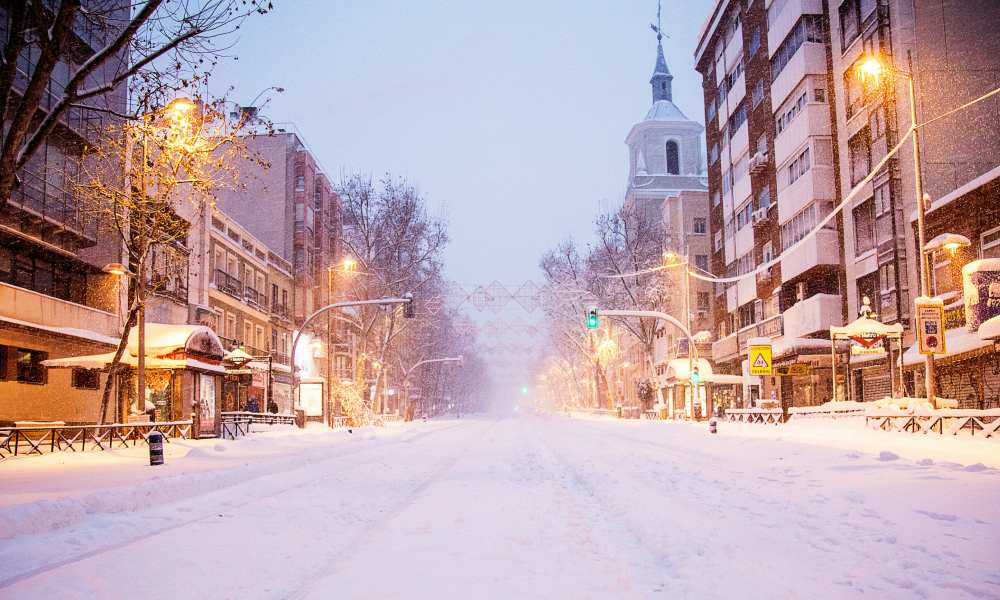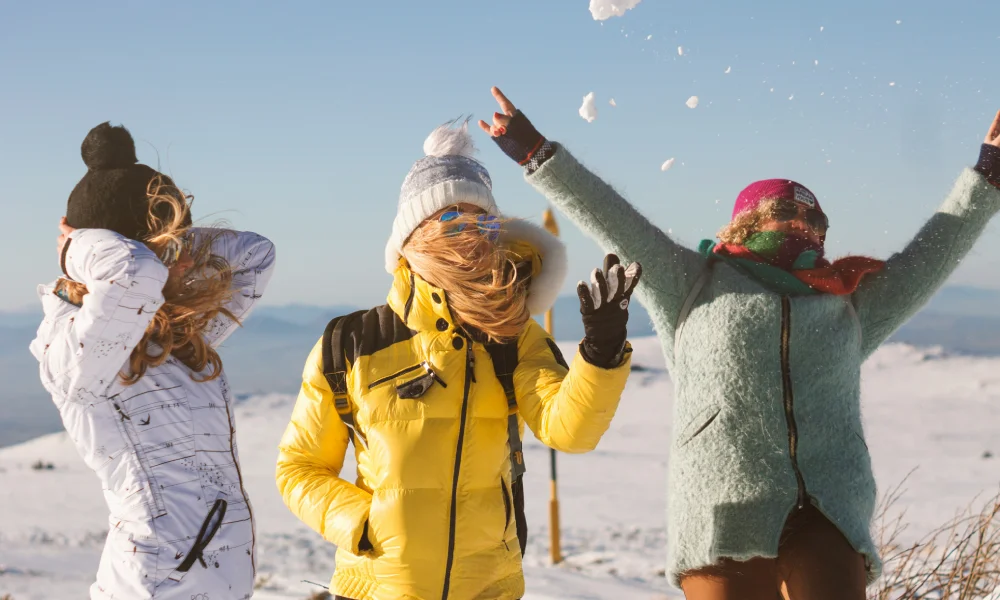Spain is famous for sun-soaked beaches, tapas on terraces, and long summer nights. But here’s the surprise: Spain also gets real winter snow, ski resorts, and frosty mountain towns included. If you’re picturing a country that’s warm year-round, this guide will reshape your map. We’ll break down where it snows in Spain, what winter activities you can enjoy, and how to plan a cold-season trip that still feels very Spanish.
What you’ll learn:
- Where it actually snows in Spain (and how much)
- The best ski areas and winter sports across the country
- What winter looks like in major cities
- Practical tips on packing, transport, and timing
- How to enjoy Spain’s winter festivals, food, and cozy vibes
Does It Snow in Spain? Short Answer
Yes, it snows in Spain—regularly in the mountains and occasionally in the interior and northern regions. The Pyrenees, the Cantabrian Mountains, and the Sierra Nevada see consistent snowfall each winter, supporting a network of ski resorts. Lower elevations and coastal areas stay mild, but cold snaps can bring rare snow to cities like Madrid, Zaragoza, or even Barcelona’s outskirts.
Spain’s Winter Weather at a Glance
- Average winter months: December to February (with snow often arriving in November and lasting into March/April in higher altitudes)
- Mild zones: Mediterranean coast, Canary Islands, parts of Andalusia’s lowlands
- Cold/snow-prone zones: The Pyrenees, Cantabrian Mountains, Iberian System, Central System (Sierra de Guadarrama, Sierra de Gredos), and Sierra Nevada
Where It Snows: Regions and Mountain Ranges
The Pyrenees (Catalonia, Aragon, Navarre)
This is Spain’s snow powerhouse, stretching along the French border. It gets reliable snowfall and offers some of the country’s best skiing and mountaineering.
Key highlights:
- Baqueira-Beret (Catalonia): Spain’s largest and most prestigious ski resort, with modern lifts, long runs, and excellent off-piste. A favorite of Spain’s royal family.
- Formigal-Panticosa (Aragon): Extensive terrain, lively après-ski, and family-friendly zones.
- La Molina & Masella (Catalonia): Convenient for Barcelona-based trips; good for intermediates and night skiing at Masella.
Snow window: Late November to early April, often peaking in January–March.
Sierra Nevada (Andalusia)
Just outside Granada, Sierra Nevada is one of Europe’s highest ski areas—and you can ski in the morning and be on a sunny terrace in the city by afternoon.
Key highlights:
- Pradollano: A compact resort village with a mix of hotels and apartments.
- Long season: Thanks to elevation (peaks over 3,000 meters), the season often runs from late November into April.
- Bonus: Combine skiing with an Alhambra visit and tapas in Granada.
Cantabrian Mountains (Asturias, Cantabria, Castile and León)
These lush northern ranges get frequent winter storms off the Atlantic.
Key highlights:
- Alto Campoo (Cantabria): A well-loved regional resort with solid snow when systems roll in.
- San Isidro & Fuentes de Invierno (Asturias/León): Smaller, local-feel resorts great for families and learning.

Central System (Near Madrid: Sierra de Guadarrama, Sierra de Gredos)
Madrid sits on a plateau, and the nearby mountains collect snow through winter.
Key highlights:
- Puerto de Navacerrada & Valdesquí: Popular with Madrid locals for weekend skiing and sledding.
- Hiking and snowshoeing: On heavy-snow days, trails transform into winter routes with beautiful pine forests and vistas over the Meseta.
Iberian System (Soria, Teruel, La Rioja)
A rugged interior range that catches cold air and periodic snow.
Key highlights:
- Valdezcaray (La Rioja): Small but scenic, with views over vineyards on clear days.
- Javalambre & Valdelinares (Teruel): Accessible for Valencia and Zaragoza residents, good for beginners.
The Balearic and Canary Islands
- Mallorca: Its Tramuntana Mountains can see light, occasional snowfall at higher elevations, though it’s not reliable for winter sports.
- Canary Islands: Spring-like year-round; Mount Teide on Tenerife sometimes gets a dusting, but beaches remain the main draw.
Winter in Spain’s Cities: What to Expect
- Madrid: Cold and dry, with average winter highs around 50°F/10°C. Snow is occasional but can be heavy during rare cold snaps. Great museums, hearty stews, and festive lights make winter cozy.
- Barcelona: Milder, with rare snow at sea level. Expect cool, damp days and lighter tourist crowds. Mountains to the north can be snowy for day trips.
- Granada: Crisp winter air with the snow-capped Sierra Nevada as a backdrop. Nights can be chilly; daytime sun is common.
- Bilbao/San Sebastián: Cooler, wetter Atlantic climate. Snow is uncommon at sea level, but nearby hills can get a dusting.
- Seville/Málaga: Mild winters—think light jackets and terrace lunches. Head inland or up to Sierra Nevada for snow.
Spain’s Best Winter Activities
Skiing and Snowboarding
Spain offers more than 30 ski areas across its ranges, with a healthy mix of beginner-friendly slopes and off-piste for experts.
- For beginners: La Molina, Valdelinares, Javalambre, Alto Campoo
- For intermediates: Baqueira-Beret, Masella, Formigal, Valdesquí
- For advanced and off-piste: Baqueira-Beret and Formigal often deliver when storms hit; Sierra Nevada offers high alpine terrain with wide cruisers
Tip: Book lift passes and accommodation in advance for peak weekends and school holidays (Christmas–New Year and late February–early March).
Snowshoeing and Winter Hiking
Snowshoeing trails in the Pyrenees, Sierra de Guadarrama, and Picos de Europa give non-skiers access to quiet winter landscapes. Guided outings are easy to arrange in resort towns and national park gateways.
Sledding and Family Snow Parks
Most larger resorts include sledding areas, beginner zones, and kids’ clubs. Look for designated family slopes at Baqueira-Beret, Formigal, and La Molina.
Mountain Villages and Thermal Spas
- Pyrenees: Stone villages like Arties, Vielha, and Aínsa offer fireplaces, Basque and Aranese cuisine, and mountain charm.
- Thermal baths: Seek out natural hot springs and spa hotels in Catalonia, Aragon, and Galicia for a post-ski soak.
City Break + Snow Day
Base in Madrid, Zaragoza, or Barcelona and add a day on the slopes. Trains and buses connect to nearby resorts, especially from Madrid to Navacerrada/Valdesquí and Barcelona to La Molina/Masella.
Winter Food and Drink: What to Eat When It’s Cold
- Cocido madrileño: A hearty chickpea stew with meats and vegetables, served in courses.
- Fabada asturiana: Rich bean stew from Asturias—perfect after a snowy hike.
- Calçots with romesco (Catalonia): Grilled green onions in winter/spring, served at festive calçotadas.
- Churros con chocolate: Breakfast or late-night treat, ideal on chilly mornings.
- Hot wine? Not common in Spain—opt for a vermut, a Rioja reserva, or a steaming café con leche.
***You May Want to Read: What is Spain Know For ***
Practical Tips for Visiting Spain in Winter
When to Go
- December: Festive lights, markets, and holiday events. Book early for Christmas/New Year.
- January–February: Best snow conditions in many resorts; fewer crowds in cities post-holidays.
- March–April: High alpine areas still skiable; coastal spring begins.
What to Pack
- Layers: Thermal base layers for mountain days; sweaters and a waterproof shell for cities.
- Footwear: Waterproof boots or sturdy shoes with good grip for mountain towns.
- Accessories: Hat, gloves, sunglasses, and SPF for high-altitude sun.
Getting Around
- Trains: Spain’s high-speed network (AVE/Avlo/OUIGO) connects major cities quickly; regional trains and buses link to mountain towns.
- Driving: Mountain roads can require chains during heavy snow. Check weather alerts and road conditions before you go.
- Flights: If heading to the Pyrenees, Barcelona and Zaragoza are good gateways; for Sierra Nevada, fly into Granada or Málaga.
Booking Tips
- Resorts: Weekends fill up. Consider midweek stays for cheaper rates and shorter lift lines.
- Lessons and rentals: Reserve online to secure English-speaking instructors and the right gear sizes.
- Insurance: Choose a policy that covers winter sports and off-piste if you plan to explore beyond marked runs.
Safety and Etiquette
- On the mountain: Follow signage, respect closures, and carry a charged phone. In off-piste terrain, go with a guide and avalanche gear.
- In villages: Winter is quieter—book restaurants ahead in small towns, and check opening days/hours.
Common Misconceptions About Snow in Spain
- “Spain doesn’t have real winters.” False. Mountain regions get consistent snowfall and sub-zero nights.
- “Skiing in Spain is only for beginners.” Not true. Areas like Baqueira-Beret and Formigal offer advanced terrain and quality snow when storms line up.
- “You can’t combine beach and snow.” You can—especially in Andalusia, where Sierra Nevada sits close to the Costa Tropical.
Sample Winter Itineraries
- Pyrenees Long Weekend: Fly into Barcelona → drive to La Molina/Masella for a warm-up → head to Baqueira-Beret for two days → return via a night in Girona’s old town.
- Sierra Nevada City + Snow: Base in Granada for tapas and the Alhambra → ski two days in Sierra Nevada → day trip to Málaga for sun and seafood.
- Northern Mountains & Food: Land in Bilbao → drive to Alto Campoo or Picos de Europa for snowshoeing → finish with pintxos in San Sebastián.
Spain’s Winter Charm, Beyond the Slopes
Even if you don’t ski, winter in Spain offers a calm, local feel that summer crowds can overshadow. Museums are quieter, restaurants easier to book, and prices (outside holidays) more forgiving. You’ll discover warm-lit plazas, steamy churro shops, and mountain views dusted in white—memories that stick long after the trip.
Ready to Explore Spain in Winter?
Swap the beach towel for a wool scarf and see a different side of Spain. Whether you’re carving turns in the Pyrenees, sipping hot chocolate in Madrid, or wandering Granada under snow-capped peaks, winter here has its own kind of magic. Start planning your cold-season escape and experience Spain’s snowy side for yourself.
